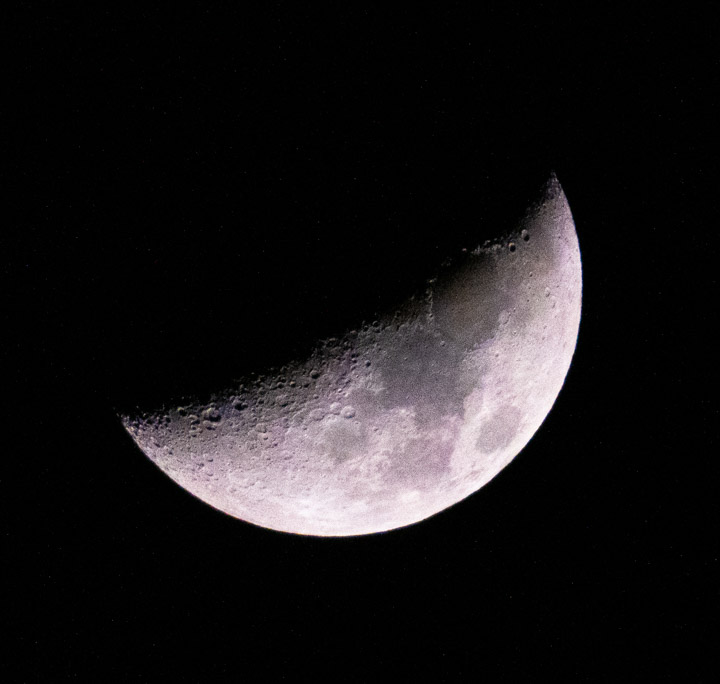
AI Noise Reduction

What happened was, there was a pretty moon in the sky, so I got out a tripod and the big honkin’ Tamron 150-500 and fired away. Here’s the shot I wanted to keep.
Sadly, the clouds had shifted
and Luna had lost her pretty bronze shading.
I thought the camera and lens did OK given that I was shooting from sea level through soggy Pacific-Northwest winter air. But when I zoomed in there was what looked like pretty heavy static. So I applied Lightroom to the problem, twice.
I’ll be surprised if many of you can see a significant difference. (Go ahead and enlarge.) But you would if it were printed on a big piece of paper and hung on a wall. So we’ll look at the zoomed-in version. But first…
Noise reduction, old-school · Lightroom has had a Luminance-noise reduction tool for years. Once you wake it up, you can further refine with “Detail” and “Contrast” sliders, whose effects are subtle at best. For the moon shot, I cranked the Luminance slider pretty all the way over and turned up Detail quite a bit too.
Noise reduction, with AI · In recent Lightroom versions there’s a “Denoise…” button. Yes, with an ellipsis and a note that says “Reduce noise with AI.” It’s slow; took 30 seconds or more to get where it was going.
Anyhow, here are the close-up shots.
Original first, then noise-reduced
in Lightroom by hand, then with AI.
What do you think? · I have a not-terribly-strong preference for the by-hand version. I think both noise reductions add value to the photo. I wonder why the AI decided to enhance the very-slight violet cast? You can look at the rim of one crater or another and obsess about things that nobody just admiring the moon will ever see.
It’s probably worth noting that the static in the original version isn’t “Luminance noise”, which is what you get when you’re pushing your sensor too hard to capture an image in low light. When you take pictures of the moon you quickly learn that it’s not a low-light scenario at all, the moon is a light-colored object in direct sunlight. These pix are taken at F7.1 at 1/4000 second shutter. I think the static is just the Earth’s atmosphere getting in the way. So I’m probably abusing Lightroom’s Luminance slider. Oh well.
You could take this as an opportunity to sneer at AI, but that would be dumb. First, Lightroom’s AI-driven “select sky” and “select subject” tools work astonishingly well, most times. Second, Adobe’s been refining that noise-reduction code for decades and the AI isn’t even a year old yet.
We’ll see how it goes.
Comment feed for ongoing:
From: Nick Radcliffe (Jan 10 2025, at 23:55)
To be honest, Tim, both the noise-reduced versions look overprocessed to me.
To me, the purple looks all wrong, and I would definitely convert the whole picture to B&W, and probably do a lighter version of the manual processing. I feel like you've imoprved the definition of the craters, but lost too much detail in the non-crater areas, which look smeary to me.
The AI version has cranked up the purple so much that visually areas of the grey look green to me, though using a colour meter, I think they're not really: it's just that the strong purples make them look green.
I think given a straight choice between these three, I'd keep the original, but I think there's a middle ground (in B&W) that would be better.
[link]
From: Elliott (Jan 11 2025, at 09:37)
I think the original looks best even with the noise. It’s a toss up for me between the edited ones. The original has character; the edited ones both look smeared and blurry to me.
[link]
From: Sophie (Jan 11 2025, at 10:22)
Hi,
I favour the original. Maybe because I did night photography on film a very long time ago, I like the grain.
When you posted the photo to Mastodon, I wondered where the purple was coming from.
[link]
From: David (Jan 12 2025, at 20:37)
IMO, the best noise reduction you can get is from DxO Photolab (or PureRAW). It's worth checking out. The enhanced purple color is annoying, but you should also be able to take that out fairly easily with HSL adjustments.
[link]
From: Lorenzo Gatti (Jan 27 2025, at 02:39)
The "traditional" noise reduction might be overly smoothed, but the AI noise reduction is hallucinating tinted shapes.
The former is therefore far superior: unnatural smoothing can be easily corrected with milder parameter choices, while ghosts are not only impossible to correct but difficult to detect without a close comparison to the noisy original.
In a Moon view, perfectly grey and with no structures other than round craters, detecting artifacts is much easier than, for example, in a Earth landscape, potentially containing man-made or natural structures with unpredictable colours and shapes.
[link]
From: Len (Feb 02 2025, at 16:27)
My experience with IzoTope Nectar is quite good. Put it on a bus and route the vocal block to it to avoid stressing the processors. It glued them together nicely. I do use eq and a compressor after normalizing the tracks is right in the pocket. My experience with the Vivago.ai is satisfactory. Learning to prompt and avoid the hallucinations takes a bit of thought. It is an art form. Consistency is a challenge. AI music? No way. That takes me out of the work. I consider AI songs not as original works but commissions. The same for the video. As for cloning, nope. As close as it gets to soul stealing.
[link]
From: Thomas Philips (Feb 04 2025, at 06:34)
DXO Photolab's algorithm appears to be the gold standard for noise reduction in digital photographs. They now have an AI enhanced (???) version (see the review at https://fstoppers.com/reviews/dxo-photolab-8-improves-noise-reduction-adds-hue-masks-and-helpful-preview-679784) that works remarkably well. I use it routinely and am happy with it.
[link]